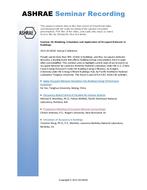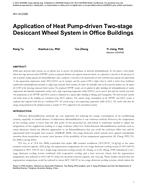The wall system is a key component of an energy-efficient building. Incremental increases in building enclosure insulationlevels have resulted in reduced heat loss and space heating loads. However, there are challenges that arise, including changesin the construction process and concerns about the long-term durability of these new assemblies. Of primary concern are the effectsof higher insulation levels on the overall moisture performance and durability of the building enclosure. In the past, some practitionersand designers have resisted the use of low permeability exterior insulation as part of a high R-value wall system becauseof the concern that it will reduce drying and result in moisture accumulation within the wall system. An alternative approach toachieving high R-values is to use thick (20-50 cm [8-20 in.]) cavity spaces filled with insulation. A field study was conductedof four full-scale high-R (approximately R-30 effective) wall assemblies and one standard wall (for comparison), on both the northand south orientation, using both exterior insulation construction and thick insulation-filled wall systems. The study wasperformed in Waterloo, Ontario, which is on the border of IECC Climate Zones 5 and 6. The measured moisture performancedata from the full-scale test walls along with interior and exterior boundary conditions was used to validate a hygrothermal modelfor the testing location. The model was then used to predict performance in Climate Zones 4 through 8. Both the field measurementsand hygrothermal modeling demonstrated that exterior-insulated walls were much more tolerant to cold weather moisture accumulationas a result of interior air leakage into the assembly than thick cavity-insulated walls. There was also correlation betweenmeasurements and hygrothermal modeling on the slow drying of the wood sheathing following a rain leak with low permeanceexterior insulation and interior vapor barrier. However, when the interior vapor barrier layer was removed, the assembly driedmuch more quickly. Both the field measurements and hygrothermal analysis from this study showed that the least risky wall withrespect to moisture-related durability issues was an exterior-insulated wall with sufficient exterior insulation to allow a ClassII or Class III vapor control layer to be used on the interior.
Citation: Thermal Performance of Exterior Envelopes of Whole Buildings XIII, Conference Papers
Product Details
- Published:
- 2016
- Number of Pages:
- 11
- Units of Measure:
- Dual
- File Size:
- 1 file , 2.2 MB
- Product Code(s):
- D-BldgConf16-48


